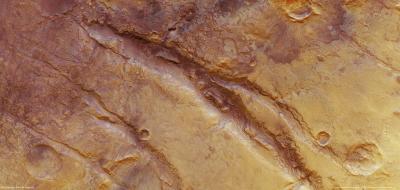Newly released images from ESA's Mars Express show Nili Fossae, a system of deep fractures around the giant Isidis impact basin. Some of these incisions into the martian crust are up to 500 m deep and probably formed at the same time as the basin.
Nili Fossae is a 'graben' system on Mars, northeast of the Syrtis Major volcanic province, on the northwestern edge of the giant Isidis impact basin. Graben refers to the lowered terrain between two parallel faults or fractures in the rocks that collapses when tectonic forces pull the area apart. The Nili Fossae system contains numerous graben concentrically oriented around the edges of the basin.
It is thought that flooding of the basin with basaltic lava after the impact that created it resulted in subsidence of the basin floor, adding stress to the planet's crust, which was released by the formation of the fractures.
A strongly eroded impact crater is visible to the bottom right of the image. It measures about 12 km across and exhibits an ejecta blanket, usually formed by material thrown out during the impact. Two landslides have taken place to the west of the crater. Whether they were a direct result of the impact or occurred later is unknown.

Nili Fossae is a graben system on Mars. It is found at 22°N / 77°E, northeast of the Syrtis Major volcanic province, on the northwestern edge of the giant Isidis impact basin. This image shows an area covering approximately 10,300 sq km. It was taken during orbit 5270, on Feb. 8, 2008, using the High-Resolution Stereo Camera on Mars Express.
(Photo Credit: ESA/DLR/FU Berlin (G. Neukum))
A smaller crater, measuring only 3.5 km across, can be seen to the left of centre in the image and this one does not exhibit any ejecta blanket material. It has either been eroded or may have been buried.
The surface material to the top left of the image is much darker than the rest of the area. It is most likely formed of basaltic rock or volcanic ash originating from the Syrtis Major region. Such lava blankets form when large amounts of low-viscosity basaltic magma flow across long distances before cooling and solidifying. On Earth, the same phenomenon can be seen in the Deccan Traps in India.
Nili Fossae interests planetary scientists because observations taken with telescopes on the Earth and published in 2009 have shown that there is a significant enhancement in Mars' atmospheric methane over this area, suggesting that methane may be being produced there. Its origin remains mysterious, however, and could be geological or perhaps even biological.
As a result, understanding the origin of methane on Mars is high on the priority list and in 2016, ESA and NASA plan to launch the ExoMars Trace Gas Orbiter to investigate further. Nili Fossae will be observed with great interest.
Source: European Space Agency